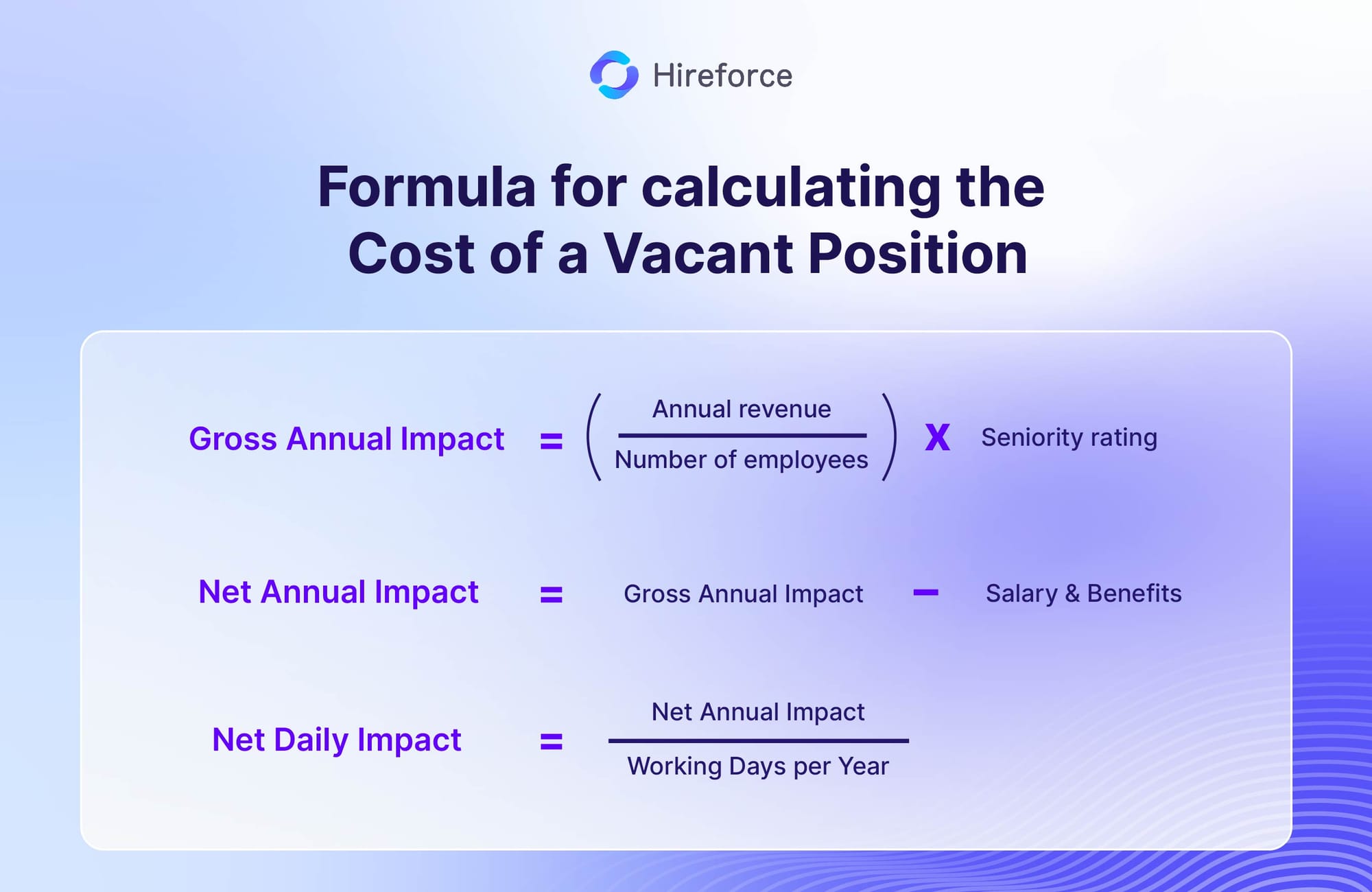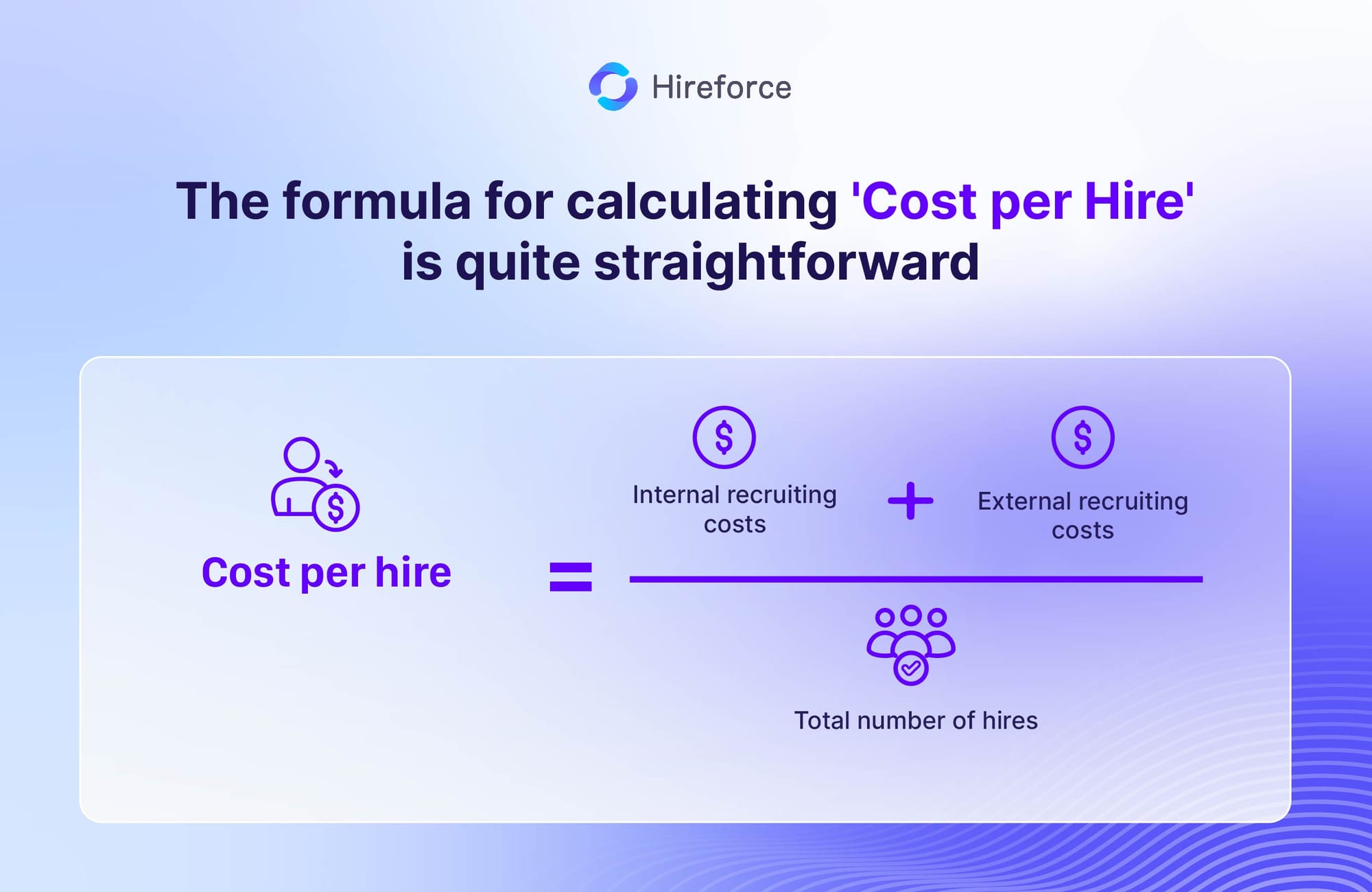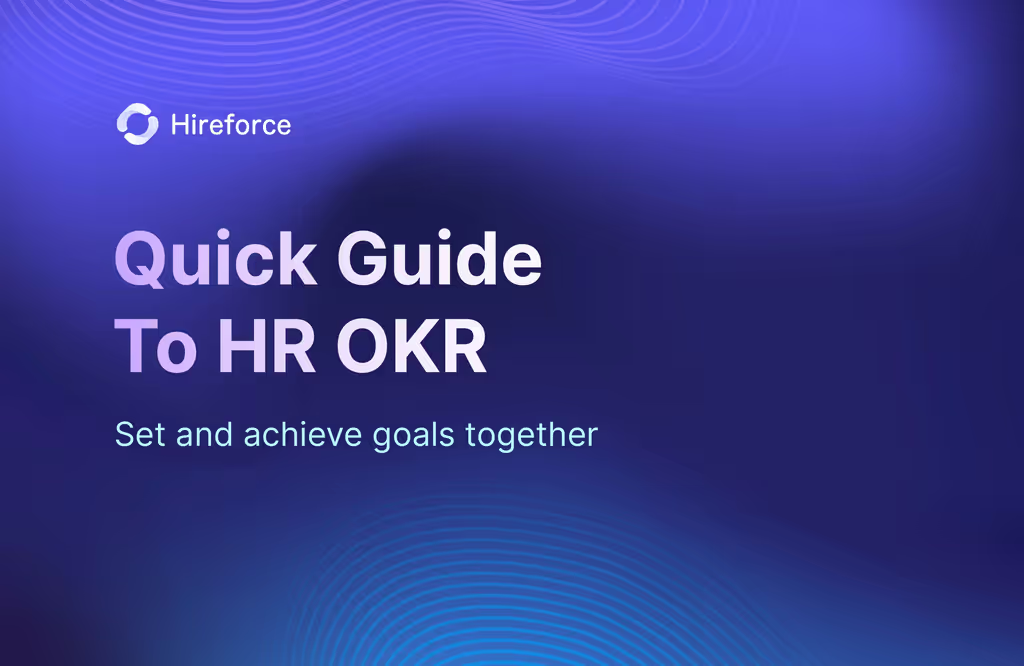How much is the cost of recruiting a new employee?
Cost per Hire is one of the most frequently used metrics by HR team and a crucial HR KPI in the recruitment process. Understanding Cost per Hire enables you to make better strategic decisions when investing in your company's recruitment efforts. In other words, it aids in decision-making regarding recruitment-related expenses and estimates the cost of hard-to-fill positions.
Numerous costs are associated with recruiting a new employee to fill a vacancy, with some costs being explicit and others hidden. For instance, how do you quantify the loss of a vacant position? Or how do you calculate the total cost of the interview process? This makes Cost per Hire one of the most critical yet challenging metrics in the field of recruitment and talent acquisition. Let's explore the definition, formula, calculation methods, and strategies to reduce the Cost per Hire with Hireforce.
What is Cost per Hire?
Cost per Hire is an HR metric that measures the total expenses associated with recruiting a new employee.
It encompasses all costs of hiring and onboarding a new staff member, including recruitment costs, equipment, travel expenses, administrative fees, and benefits. For example, if your company hires 50 people annually and spends approximately 100.000 USD on recruitment, your cost per hire would be 2.000 USD. This is a common method to gauge whether your recruitment process is optimized compared to your company and industry standard.
Additionally, it is useful for comparing different departments across quarters and annually to identify any significant trends.
Identifying hidden costs in recruitment
1. Cost of a vacant position
Typically, at the end of the recruitment process, companies must wait for candidates to complete their notice period at their current employment. This can add a significant amount of time to filling a vacancy. During this time, the company will lose direct revenue if the position generates revenue, or indirect revenue for supporting roles within the functional group. Additionally, this has various other impacts, such as arranging employee leave to avoid work disruptions or the number of tasks that need to be handled simultaneously.
A recent survey by the CIPD (Chartered Institute of Personnel and Development) revealed that 14% of businesses have increased their focus on retaining talent. However, turnover is inevitable in most companies and occurs annually, so these costs cannot be eliminated.
To calculate the cost of a vacant position, we can leverage the company's annual revenue, the number of employees, and a seniority rating (0.75 for employees, 1.5 for mid-level employees, 3 for senior/C-suite executives) to compute the aggregate impact as follows:
From this, we can subtract the salary and any benefits the employee would have received:
Finally, we can divide this by the average number of working days to obtain a daily impact rate.

To illustrate this further, let's consider the following example:
- Mattel, a "Project Manager" (middle management), leaves Company Z.
- Mattel's annual salary is 90.000 USD.
- Company Z has an annual revenue of 15 million USD and 200 employees.
- Gross Annual Impact = (15 million USD / 200 employees) x 1.5 (middle management level) = 112.500 USD
- Net Annual Impact = 112.500 USD - (90.000 USD salary + 20.000 USD benefits) = 2.500 USD
- Net Daily Impact = 2.500 USD / 260 working days per year ≈ 9.6 USD
If position A remains vacant for 1 month or 22 working days, Company Z will incur a cost of 22 days x 9.6 USD = 211.2 USD
2. Productivity costs of a new employee
While a new employee is familiarizing themselves with their predecessor's role, it's reasonable to expect lower productivity compared to someone who has been in the position for a longer period and is well-versed in the job. There is an inherent investment of time and resources during the onboarding process as managers and other training partners help the new employee acclimate to the role. This process can take anywhere from 1-2 months; however, investing in a solid onboarding experience is worthwhile as it can increase employee retention rates.
According to the Retention Report by Workinstitute.com, 43% of new hires leave their jobs within the first 90 days. This significantly increases recruitment costs due to the time and resources spent on onboarding, not to mention the additional costs of a second recruitment.
Moreover, the issue extends beyond the employee. A 3BL study on New Hire Productivity in 2023 found that 57% of new hires in the past 12 months were not fully productive in at least one area, and 25% were not. The top reasons cited were a mismatch for the role (46%) and a poor cultural fit (44%).
A study by the REC (Recruitment & Employment Confederation) on Hiring the Right Person & the Cost of Getting it Wrong in the UK revealed that a bad hiring decision for a middle-management position paying £42,000 per year could cost a business over £132,000 to rectify, emphasizing the importance of finding the right person for the job
3. The cost of human capital flight
The cost of losing knowledge and expertise, often referred to as brain drain, is rarely quantified but is a significant hidden cost for businesses. When successful employees or those with specialized skills leave a company, the organization loses valuable knowledge and experience. This loss can be in the form of organizational knowledge about processes and procedures or more specialized technical expertise.
Focusing on retaining top talent is crucial. Ensuring adequate documentation and sufficient time for knowledge transfer can mitigate some of the impact of knowledge loss.
Calculating Cost per Hire
The formula for calculating 'Cost per Hire' is quite straightforward:

However, determining the specific internal and external costs, as well as the exact number of hires, can be a complex task for managers. The recruitment process varies in complexity from one company to another, and costs are calculated for each step accordingly. The more detailed your cost analysis for each hire, the more accurate your results will be.
To better understand internal and external costs, please refer to the detailed information below:
1. Internal recruiting costs
| Component | Detailed explanation |
|---|---|
| Hiring manager costs | Costs are associated with the time a "hiring manager" spends recruiting and onboarding a new employee. |
| HR recruitment costs | Total costs (salary, bonus, and benefits) of the recruitment department. |
| Training and development costs | All costs related to the L&D department and relevant HR staff. |
| Administrative costs | Any costs related to handling recruitment documents (e.g., legal papers or immigration procedures...). |
| Admin costs | Other costs related to supporting recruitment, such as office equipment, rent, and other expenses. |
2. External recruiting costs
| Component | Detailed explanation |
|---|---|
| Freelancers and Headhunting Companies | Fees are paid to external recruitment agencies to find candidates for open positions. |
| Job Posting Fees and Other Marketing Costs | Costs associated with advertising a specific position to reach potential candidates. This may include paid job boards, job fairs, or social media recruitment. |
| Pre-Screening Costs | Costs related to screening candidates for quality and suitability (including skills assessment before recruitment). |
| Background Checks | Costs incurred to investigate a candidate's background. For example, completing employment references, verifying educational qualifications and degrees, conducting criminal background checks, or confirming immigration status. |
| Referral Bonuses or Sign-on Bonuses | Any incentives offered to current employees (in case of referral programs) or new hires (in case of sign-on bonuses) to secure new hires. |
| Technology and HR Software Costs | Fees for technology and software related to the HR process, such as applicant tracking systems (ATS) or candidate assessment software. |
3. Total number of hires
To evaluate the recruitment cost on a per-headcount basis, we need to divide the total internal and external recruitment costs by the number of new employees hired.
Depending on the analysis objectives, the HR department can calculate the total number of positions filled in the Cost per Hire formula in several different ways:
- Inclusive approach: Include both internal and external hires to assess the overall cost of all new employees. Alternatively, only include new hires from a specific recruitment channel.
- Employee categorization: Include all employee groups, such as full-time, contract, temporary, and outsourced support staff. Or only include a specific employee type for a particular analysis.
- Timeframe: Include all new hires and trainees in the past year. Or isolate a different timeframe (e.g., only include new hires in the past quarter).
While there is no universally accurate method for evaluating the cost per hire, it is essential to identify the internal and external costs associated with recruiting each type of employee hired. This will allow for a more accurate calculation of the Cost per Hire for specific employee groups.
4. Examples of Cost per Hire
To illustrate this further, let's consider a practical example.
Imagine you are the HR Manager at a large technology company, Company Z. You are preparing a report on the recruitment cost (Cost per hire) for your company in the previous quarter.
Here is the information you would need to list for the most accurate results:
| Component | Detailed explanation | Cost |
|---|---|---|
| Internal recruitment costs | 1. Hiring manager costs: 2.500 USD 2. Recruitment team costs: 5.400 USD 3. Administrative costs: 500 USD | 8.400 USD |
| External recruitment costs | 1. Background check costs: 4.600 USD 2. Sourcing costs: 2.100 USD 3. Job posting costs: 6.200 USD 4. Headhunting service costs: 2.600 USD 5. Technology and related software costs: 4.500 USD | 20.000 USD |
| Total cost | Includes both internal and external costs | 28.400 USD |
In the previous quarter, Company Z hired a total of 10 full-time employees and no other types of employees.
Therefore, the recruitment cost, or Cost per hire, would be an average of 28.400 USD for each new employee.
However, in reality, your recruitment cost (Cost per hire) will depend largely on the following factors:
- Job position and cost of living
- Skill level
- Job level
- Employee type
- Location or function
Therefore, only you can accurately determine which costs should be included in your company's recruitment cost (Cost per hire).
5. Recruiting Cost Rate (RCR) or Recruitment Cost Ratio
The Recruiting Cost Rate (RCR) is a useful KPI to consider alongside Cost Per Hire to measure the cost-effectiveness of an organization's recruitment efforts. (*)
It is calculated by dividing the total recruitment costs over a specific period by the total compensation for new hires during the same period.
By expressing recruitment costs as a proportion of total compensation, RCR provides a more detailed view of the recruitment process's efficiency.
A low RCR indicates that the company is effectively attracting talent, while a high RCR suggests inefficient spending relative to the level of compensation paid to employees.
Even when recruiting for higher-level positions (C-level and above) is more challenging and expensive, the RCR can help companies find an effective balance in spending on positions at all levels.
(*) Source: TestGorilla
What does the Cost per Hire metric reveal about a business?
The Cost per Hire metric for your company only becomes truly meaningful when you have a benchmark for comparison.
By comparing your company's Cost per Hire to a standard, you can identify any anomalies or inefficiencies in your recruitment process that may require adjustments.
One effective method is to track your company's Cost per Hire over time. A significant increase might indicate a decline in recruitment efficiency, prompting a deeper investigation into the underlying causes.
Additionally, you can benchmark your Cost per Hire against industry standards for your specific sector or the broader market.
Limitations of Cost per Hire
While Cost per Hire is a useful metric, it's important to remember that minimizing costs isn't the sole objective of HR.
For instance, if your company has a low Cost per Hire but the hired employees underperform, have short tenures, and frequently leave within a year, the Cost per Hire formula needs to capture the costs of a poor hire fully.
Even if your Cost per Hire is improving, the overall picture might still need to be clarified. This is because we are overlooking another crucial aspect: Quality per Hire. In a future article, we will delve deeper into the Quality per Hire metric.
Ultimately, the primary goal is to recruit top talent who can deliver exceptional value to the company. This involves striking a balance between optimizing Cost per Hire and hiring high-quality employees.
Tips to optimize recruitment costs
Utilize the proven strategies outlined below to gain deeper insights into your HR data and enhance your company's recruitment process
| Best practices to optimize Cost per Hire | Why use these methods? |
|---|---|
| Monitor Cost per Hire against benchmarks | Benchmarks help your company determine the appropriate Cost per Hire range. |
| Divide Cost per Hire by recruitment source | Different recruitment sources have different cost levels. Analyzing Cost per Hire by source provides a more detailed view. |
| Compare internal results | Cost per Hire is easier to understand when calculated for similar roles across departments in your company. |
| Consider quality and time | Costs must be carefully weighed against metrics for candidate quality and hiring time. |
| Shift to lower-cost recruitment methods | By analyzing Cost per Hire, your company can identify the most effective recruitment methods. |
| Commit to skills-based recruitment methods | Skills-based recruitment methods not only save time and money but also provide a better view of candidate quality. |
| Add context to the KPI | Calculating your company's Cost per Hire must be considered about market and industry trends. |
Benchmarking your Cost per Hire
A key to interpreting your company's Cost per Hire is to compare your results to reliable industry benchmarks. This could be internal company data, such as comparing this quarter's Cost per Hire to historical trends, or it could be external benchmarks like average industry Cost per Hire.
These comparisons will help your company make informed assessments of the effectiveness of its recruitment process. However, it's important to remember that the input data for calculating Cost per Hire can also be influenced by broader economic and labor market factors beyond your control.
Breaking down costs by recruitment source
Analyzing Cost per Hire at a more granular level can provide more detailed insights into your organization's staffing.
One way to do this is to segment new hire costs based on recruitment sources.
For example, you could break down your Cost per Hire data based on channels such as:
- New hires sourced from employee referrals
- New hires sourced from freelancers or headhunters
- New hires sourced from fee-based job boards or recruitment software
Investigating the Cost per Hire for each channel might reveal that employee referrals are significantly more cost-effective and result in a higher number of hires. In fact, on average, employee referral programs save up to $1,000 and take 13 days less to fill a position (Source: Zippia.com).
In this case, the company could reallocate resources to focus on more effective channels and scale back less effective recruitment sources.
Comparing internal results by department and position
Another way to make Cost per Hire results more specific is to analyze data for different departments or job positions. You might find that the Cost per Hire for software engineers is higher than for customer service representatives.
It's not necessarily better or worse for one position over the other when we aggregate all the data and put it on the same scale. The weaknesses or shortcomings of other departments might be obscured.
Instead, you'll gain more granular insights by comparing Cost per Hire for specific positions in each department.
Considering quality and time for a holistic view
To get a complete picture of your company's recruitment, you need to consider Cost per Hire time-to-hire, and quality of hire.
As mentioned earlier, a low Cost per Hire isn't necessarily a good indicator if recruitment performance is poor or if candidates take a long time to engage with your recruitment channels.
One of the best ways to improve both quality of hire and time-to-hire is to use pre-employment screening tests.
By assessing skills as part of the recruitment process, recruiters can effectively focus on the most qualified candidates. This saves time in the recruitment process and makes it easier to evaluate candidate quality.
Shifting to lower-cost recruitment methods
By considering the internal and external cost factors of recruitment discussed above, you may notice that certain recruitment methods can be more expensive than others.
Understanding the contribution of each item to the total Cost per Hire can help your company shift to lower-cost recruitment methods such as encouraging internal mobility.
Commitment to skills-based recruitment methods
Attracting more qualified candidates through the recruitment process is the ultimate goal of optimizing Cost per Hire. But filling vacancies with quality talent without spending a lot of time and money finding out if they are a good fit is not an easy task.
An effective way to screen candidates is to use a skills-based recruitment process, focusing on a candidate's abilities rather than relying on resumes or broad-based job interviews.
Skills-based recruitment improves the overall quality of hire and reduces poor hiring decisions, saving the company money in the long run.
In fact, over 89% of recruiters surveyed in the 2022 Skills-Based Hiring Report (Source: TestGorilla) reported a decrease in overall Cost per Hire when using skills-based hiring methods.
In addition to cost benefits, skills-based hiring allows companies to access a wider pool of candidates and hire more diverse groups of people by eliminating subjectivity and bias.
Adding context to the KPI
An increase or decrease in Cost per Hire at your company is not necessarily a good or bad indicator. Instead of reporting Cost per Hire blindly, add context and explanations to understand why the KPI is behaving in a certain way.
Conclusion
It's important to note that Cost per Hire is a crucial metric for HR managers to consider. However, it is not flawless, and managers will need to consider other metrics, in addition to a comprehensive and balanced view of goals, costs, and quality, to help the business succeed.
Check out Hireforce’s quick guide to HR OKRs to get a better understanding of how to set up, implement, track, and analyze HR OKRs and KPIs (include our free OKR template)






